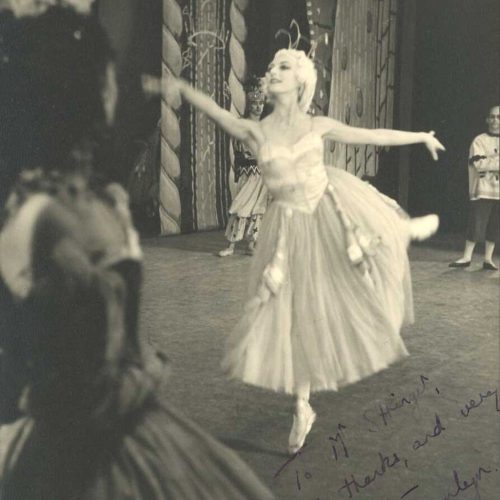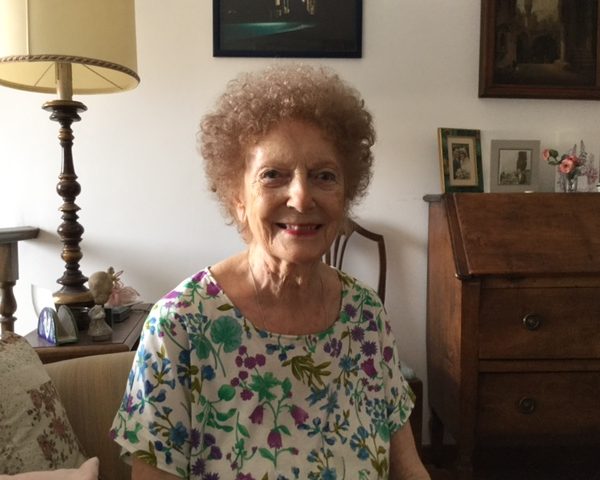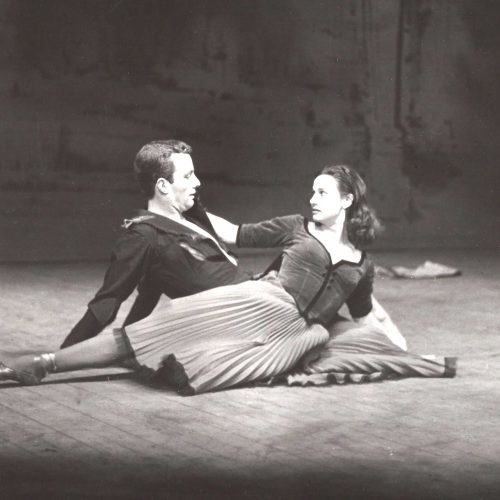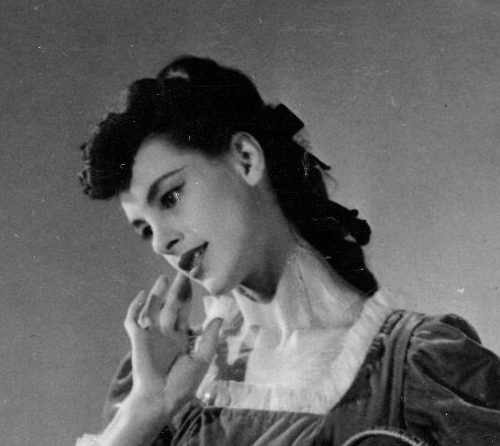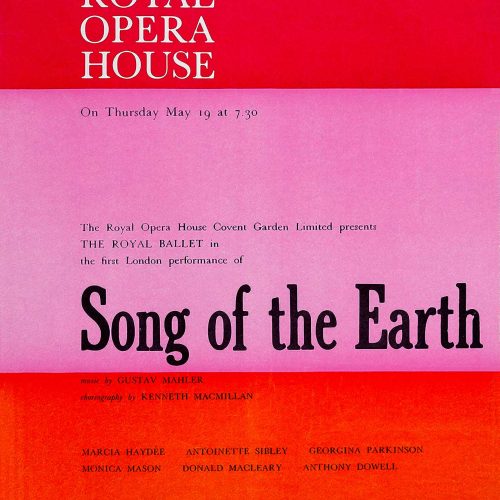Brenda Hamlyn
Natalie Steed talks to Brenda Hamlyn-Bencini about training under Marie Rambert, the post-war dance scene and touring Germany with ENSA in the immediate aftermath of WWII.
At 92, Brenda Hamlyn-Bencini describes events and people from the 1940s, as if it was yesterday. She certainly does not dispel any myths about ‘Mim’ [Marie] Rambert’s powerful personality. Brenda talks candidly of her days at Cone Ripman School during the war, and of taking classes with Rambert herself in London, whom, for all her harshness, she admired. She joined Ballet Rambert and speaks of the devastation she witnessed on an ENSA tour of Germany straight after the war. Brenda also speaks of working with Walter Gore and Frank Staff. Hamyln-Bencini is remembered as a wonderful teacher and lifelong advocate and devotee of the Cecchetti method.
First published: May 13, 2025
Biography
Brenda Hamlyn was born in London in 1925. She trained at the Cone Ripman School from 1934-41. She started taking classes with Marie Rambert in London, as a result of which she began working for Lunch Time Ballet in 1941. A short period with the Ballet Guild was followed by full membership of Ballet Rambert from 1943-8. During this time she toured extensively with Rambert, including an ENSA tour to Germany immediately after the war, and a tour to Australia and New Zealand in 1947-8. In 1948 she joined the Empire Ballet in Leicester Square, and began taking classes with Vera Volkova and Stanislas Idizikowski. In 1951 she went to Milan, and began dancing throughout Italy and other parts of Europe, including Salzburg and Cologne.
In 1963 Brenda Hamlyn opened her own Scuola de Danza Hamlyn in Florence, qualifying shortly after as a Cecchetti teacher. She has since become internationally renowned as an expert on and practitioner in the Cecchetti Method. In 1987 she became a Cecchetti examiner and in 1989 President of the Cecchetti Society of Italy. On stepping down from directorship of her own school after 23 years, she continued to teach and lecture in many countries on the Cecchetti Method until well into the 1990s. In 1996 she won the Enrico Cecchetti Medal and, in 1998, the Premio Cecchetti.
Transcript
In conversation with Natalie Steed
Brenda Hamlyn: I was born in London on the 23rd of May, 1925. And I can remember my first ballet class. I was put in the front row when we got to centre and everybody was stopped to see me do such and such a pointe of the foot or use of the arm, I can’t remember those details but that kind of thing. And at the end of the class, no, the end of the week, the teacher took Mummy in a corner and said, ‘I think your daughter should become a dancer.’
And by that time I was at the Commonweal Lodge Girls’ School, at the top of the hill at Purley, Surrey. They allowed me to go to Ballet School also and, fortunately, for me, in the class I palled up with my very best friend, who was, right to the end, a few years ago, one of my very best friends, Moyra Fraser. And when she was about 13, she was a little older than me, she went one way and I went the other and they sent her to an audition at the Sadler’s Wells School and Ninette de Valois took her right away and she was with the company, I think, for about 3 or 4 years, maybe more, by which time, the war had broken out and I was sent with the Cone Ripman College.
They called it the Cone Ripman College, ‘cos it was the Ripman School of Dancing, Olive Ripman, and the Ripman School amalgamated with the Cone School and it was called the Cone Ripman College and they went up to the country, in Leicestershire and hired a huge, great, old English Country House, with an enormous garden and a lot of teachers. So we had schoolwork, very little, which was fine by us, but not so good later on perhaps, I don’t know! And we were dancing all day and in the breaks we had this enormous garden to go and play in and run about in and walk for miles and cross over the little river at the bottom of the hill, you know, all that kind of thing. And, in between, after the first year, they started sending us up to London for auditions.
Natalie Steed: And did you dance in the Lunch Time Ballets at the Arts Theatre [in London]?
Brenda Hamlyn: Oh yes, that’s how I met [Marie] Rambert…because somebody said, you must go to West Street and go to Rambert’s classes and I met her there and of course she grabbed me and took me down to the rehearsals of Sylphides, one day, during which somebody was sick and nobody to replace her and she knew I’d learned it at school and she grabbed me and she said, ‘Brenda, you will be on tonight’, ha, I nearly died. I said, ‘What?’. But I did know all the corps de ballet work, because we’d learned it during the war at the Cone Ripman College. It was fantastic. And just now and again I had a bump with somebody, but this somebody would hiss at me, ‘No! The other way!’ You can see the scene and it didn’t matter because it was the finale. I don’t think she quite put me in the couples all down the lines straight away because it was more obvious to the audience if I went wrong. Yes, I can see it to this day, I was so shocked. My first performance on stage with my family there and friends there and we were doing … [sings] … you know the one…
Natalie Steed: You mentioned in something I’ve read about an Andrée Howard ballet?
Brenda Hamlyn: The Mermaid. Yes. Do you know what I did in The Mermaid? Sitting the whole ballet, crouched behind a wooden wave, that was, of course, a beautifully painted wave on stage, for Sally Gilmour to finish the ballet with everybody else, and Robert Harrold and so on. She did a whole pas de bourrée couru on a straight line from the front lights all the way back to a wave, a huge wave, that ran from one side to the other, width-wise, with me on one side and another girl on another waiting, crouched, like this the whole ballet just to, on the last few bars of the music, [sings], on the [sings], we popped up like two little, I don’t know what, and she just did a big pliée and we got up, took an arm each and lifted her over that wooden wave, [laughs], and she fell down on the floor with us all crouched down like this until the curtain came down… Those were the days!
Natalie Steed: You were doing class still, at this time, do you remember any of the teachers that you were working with at this time?
Brenda Hamlyn: Always Mim, always Mim, we called her Mim, Rambert. And she didn’t want a piano she didn’t want music, she whistled. Can you imagine trying to be inspired on top of all the hard work trying to get technique better with her whistle to help you along …[laughs]. Oh, she used to kill us. We used to have great difficulty not laughing, poor Mim.
Natalie Steed: What was she like to work with, or to work for?
Brenda Hamlyn: Oh, she was a devil. A real devil. We were all afraid of her. She’d just lose her patience. She had no control over herself. I think that she used it as an excuse. I can’t believe she couldn’t have controlled herself. But that was the thing, we were so used to it, we became rather, sort of, er, sarcastic about her, you know: ‘Oh, that one! Is she taking class today, oh dear, you know’. She never praised anybody, never. You never knew if you’d done well or not. She’d always call it, you, ‘filthy’. ‘That was filthy, Brenda, I’ve never seen such a terrible waltz done in Sylphides before, what are you doing? You’re taking too long on this……’ and she went on, that was her way of working. If she ever said one word to the whole class that was encouraging, she might say, ‘Hmmm. Bon.’ [or Bonne?] That’s as far as she got. But she was a powerful woman. A powerful personality and it riveted us, we were afraid of her, we loved her, we admired her. We would do anything she wanted of us. Oh yes, no that took the top and that she was the way she got through all the time, in everything. Just using that side of her personality.
Natalie Steed: After the War, you toured with ENSA, to Germany …?
Brenda Hamlyn: Yes, we were the second company to go out after the War was over. They had cleaned it up, I mean, but you could see the devastation of the houses and the buildings and everything. We were allowed, after a long lecture from the stage manager, to go out for a stroll near to the hotel, not to stray, not to talk to anybody, the full lot. And off we went, and the pavement, and the roads, was packed with people and we found ourselves being slowly pushed towards the road. They tried to nudge us, with a lost expression on their faces, elbows held to the body, but they could do that … ’cos we were so close together all of us. We found ourselves in the road. We looked at each other and said, ‘Come on, we’ve got to get back to the hotel as fast as we can,’ which we did and we never went out again. Because we shouldn’t have done that, gone and mixed with the Germans, just after the war, all in that terrible state and all they went through and all that kind of thing and we were well-fed and happy and jolly and well-dressed and so on.
Natalie Steed: Do you remember what ballets were performed?
Brenda Hamlyn: We always did a classic. It was Sylphides or Giselle, second act. We did Façade. We did some of Frank Staff’s Pas de Trois which were very good. Wally Gore was just beginning to come through, start. And when Frank had to go into the army, away, I think, totally that was Wally’s start and he did some lovely things.
Natalie Steed: What was he like to work with?
Brenda Hamlyn: Oh, charming. Very, very, just like he is, was, I mean. Calm, very quiet. You had to go up and practically lean against his shoulders to hear what he was saying, what he wanted, and, if he liked you it was very special. Nothing was done just the look on his face the way he taught you the exercise that had to be done. He was an amazing man. He fell in love with Paula Hinton who was my room mate in those days, so I sort of have more, I was a bit closer to him than the others, perhaps.
Natalie Steed: And what about Frank Staff, what was he like to work with?
Brenda Hamlyn: Frank? One always wondered with Frank whether he was going to like you or not. You were always uneasy, you were always scared out of your life. At least I was. Because he was so marvellous and so good looking and so beautiful as a dancer and everything he did was divine! Ah, my goodness me. And sometimes, you know, if you were trying over hard he’d get mad. ‘What the hell ……’ always he’d say, ‘What the hell are you doing there?’. He was very quick to snap but it was always a joy to work with him, but I never had the joy some of the others like Paula Hinton had. They were just beginning to become the principal dancers along with Sally, doing it for her on matinee days and all that kind of thing. And, erm, he, fortunately, always had a soft spot for me and I was too young and too ignorant to notice it.
Natalie Steed: Was there a lot of romance on the road, did people fall in love?
Brenda Hamlyn: Nobody! They all had them quietly and hid it from everybody. Nobody knew so and so was with so and so. No, we were so good! And so pure! And Rambert knew this and traded on it and she’d always show us off when people came to see the show or backstage or for the rehearsal during the day, you know, artistic people who wanted to see about something. She’d say, ‘Naïve’ she’d call us, the whole lot, we were all naïve and nobody mentioned the ones you knew weren’t.
The transcript of this podcast may have been lightly edited for ease of reading.

